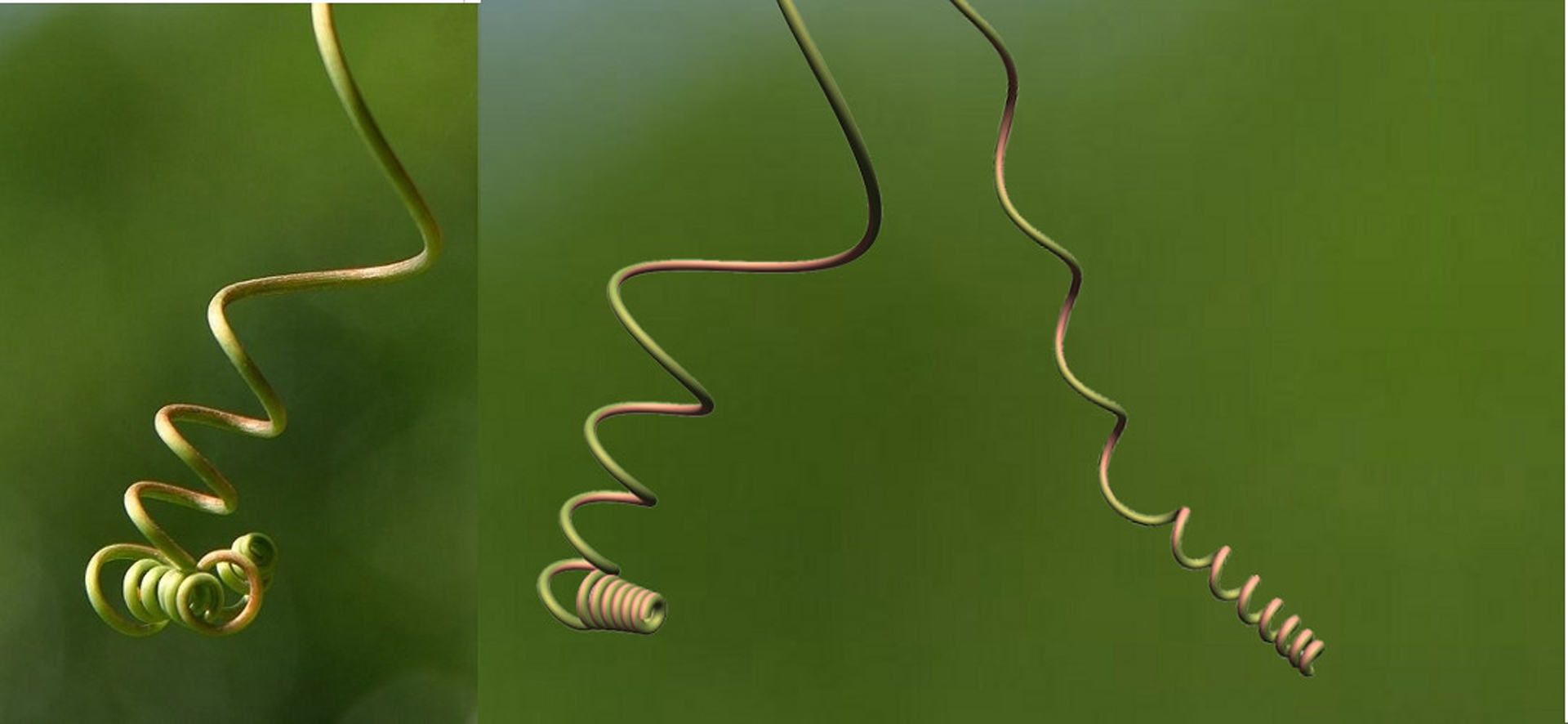“Super space clothoids” by Casati and Bertails
Conference:
Type(s):
Title:
- Super space clothoids
Session/Category Title: Rods & Shells
Presenter(s)/Author(s):
Moderator(s):
Abstract:
Thin elastic filaments in real world such as vine tendrils, hair ringlets or curled ribbons often depict a very smooth, curved shape that low-order rod models — e.g., segment-based rods — fail to reproduce accurately and compactly. In this paper, we push forward the investigation of high-order models for thin, inextensible elastic rods by building the dynamics of a G2-continuous piecewise 3D clothoid: a smooth space curve with piecewise affine curvature. With the aim of precisely integrating the rod kinematic problem, for which no closed-form solution exists, we introduce a dedicated integration scheme based on power series expansions. It turns out that our algorithm reaches machine precision orders of magnitude faster compared to classical numerical integrators. This property, nicely preserved under simple algebraic and differential operations, allows us to compute all spatial terms of the rod kinematics and dynamics in both an efficient and accurate way. Combined with a semi-implicit time-stepping scheme, our method leads to the efficient and robust simulation of arbitrary curly filaments that exhibit rich, visually pleasing configurations and motion. Our approach was successfully applied to generate various scenarios such as the unwinding of a curled ribbon as well as the aesthetic animation of spiral-like hair or the fascinating growth of twining plants.
References:
1. Antman, S. 1995. Nonlinear Problems of Elasticity. Springer Verlag.Google Scholar
2. Audoly, B., and Pomeau, Y. 2010. Elasticity and Geometry: from hair curls to the nonlinear response of shells. Oxford University Press.Google Scholar
3. Baraff, D., and Witkin, A. 1998. Large steps in cloth simulation. In Computer Graphics Proceedings (Proc. ACM SIGGRAPH’98), 43–54. Google ScholarDigital Library
4. Benham, C., and Mielke, S. 2005. DNA mechanics. Annual Review of Biomedical Engineering 7, 21–53.Google ScholarCross Ref
5. Bergou, M., Wardetzky, M., Robinson, S., Audoly, B., and Grinspun, E. 2008. Discrete elastic rods. ACM Transactions on Graphics (Proc. ACM SIGGRAPH’08) 27, 3, 1–12. Google ScholarDigital Library
6. Bergou, M., Audoly, B., Vouga, E., Wardetzky, M., and Grinspun, E. 2010. Discrete viscous threads. ACM Transactions on Graphics (Proc. ACM SIGGRAPH’10) 29, 4. Google ScholarDigital Library
7. Bertails-Descoubes, F. 2012. Super-clothoids. Computer Graphics Forum (Proc. Eurographics’12) 31, 2pt2, 509–518. Google ScholarDigital Library
8. Bertails, F., Audoly, B., Cani, M.-P., Querleux, B., Leroy, F., and Lévêque, J.-L. 2006. Super-helices for predicting the dynamics of natural hair. ACM Transactions on Graphics (Proc. ACM SIGGRAPH’06) 25, 1180–1187. Google ScholarDigital Library
9. CGSociety, 2008. SIGGRAPH’s Animation Mother. http://www.cgsociety.org/index.php/CGSFeatures/CGSFeatureSpecial/siggraph_animation_mother.Google Scholar
10. Chentanez, N., Alterovitz, R., Ritchie, D., Cho, L., Hauser, K., Goldberg, K., Shewchuk, J., and O’Brien, J. 2009. Interactive simulation of surgical needle insertion and steering. ACM Transactions on Graphics (Proc. ACM SIGGRAPH’09), 88:1–10. Google ScholarDigital Library
11. Cosserat, E., and Cosserat, F. 1909. Théorie des corps déformables. Hermann.Google Scholar
12. Crisfield, M. A., and Jelenić, G. 1998. Objectivity of strain measures in the geometrically exact three-dimensional beam theory and its finite-element implementation. Proc. Royal Society of London, Series A 455, 1983, 1125–1147.Google Scholar
13. Daviet, G., Bertails-Descoubes, F., and Boissieux, L. 2011. A hybrid iterative solver for robustly capturing Coulomb friction in hair dynamics. ACM Transactions on Graphics (Proc. ACM SIGGRAPH Asia’11) 30, 139:1–139:12. Google ScholarDigital Library
14. Dill, E. 1992. Kirchhoff’s theory of rods. Archive for History of Exact Sciences 44, 1, 1–23.Google ScholarCross Ref
15. Goldberg, D. 1991. What every computer scientist should know about floating-point arithmetic. ACM Comp. Surveys 23, 5–48. Google ScholarDigital Library
16. Goriely, A., and Neukirch, S. 2006. Mechanics of climbing and attachment in twining plants. Physical Review Letters 97 (Nov), 184302.Google ScholarCross Ref
17. Goyal, S., Perkins, N., and Lee, C. 2008. Non-linear dynamic intertwining of rods with self-contact. International Journal of Non-Linear Mechanics 43, 1, 65–73.Google ScholarCross Ref
18. Granlund, T., and the GMP development team. 2012. GNU MP: The GNU Multiple Precision Arithmetic Library, 5.0.5 ed. http://gmplib.org/.Google Scholar
19. Hadap, S., and Magnenat-Thalmann, N. 2001. Modeling dynamic hair as a continuum. Computer Graphics Forum (Proc. Eurographics’01) 20, 3, 329–338.Google Scholar
20. Hadap, S. 2006. Oriented strands – dynamics of stiff multi-body system. In ACM SIGGRAPH – EG Symposium on Computer Animation (SCA’06), ACM-EG SCA, 91–100. Google ScholarDigital Library
21. Hairer, E., Lubich, C., and Wanner, G. 2006. Geometric Numerical Integration. Structure-Preserving Algorithms for Ordinary Differential Equations, vol. 31. Springer Series in Comput. Mathematics.Google Scholar
22. Harary, G., and Tal, A. 2012. 3D Euler spirals for 3d shape completion. Computational Geometry 45, 3 (April), 115–126. Google ScholarDigital Library
23. Ivanova, E. 2000. On one approach to solving the Darboux problem. Mechanics of Solids 35, 36–43.Google Scholar
24. Mezzarobba, M. 2010. NumGfun: a package for numerical and analytic computation with D-finite functions. In ISSAC ’10. Google ScholarDigital Library
25. Neher, M. 1999. An enclosure method for the solution of linear ODEs with polynomial coefficients. Numerical Functional Analysis and Optimization 20, 779–803.Google ScholarCross Ref
26. Pai, D. 2002. Strands: Interactive simulation of thin solids using cosserat models. Computer Graphics Forum (Proc. Eurographics’02) 21, 3, 347–352.Google Scholar
27. Poole, E. 1936. Introduction to the theory of linear differential equations. Clarendon Press.Google Scholar
28. Press, W., Teukolsky, S., Vetterling, W., and Flannery, B. 2007. Numerical Recipes: The Art of Scientific Computing (Third Edition). Cambridge University Press. Google ScholarDigital Library
29. Reissner, E. 1973. One one-dimensional large-displacement finite-strain beam theory. Studies in App. Math. 52, 2, 87–95.Google ScholarCross Ref
30. Simo, J., and Vu-Quoc, L. 1986. A three-dimensional finite-strain rod model. part ii: Computational aspects. Computer Methods in Applied Mechanics and Engineering 58, 1, 79–116. Google ScholarDigital Library
31. Spillmann, J., and Teschner, M. 2007. CoRdE: Cosserat rod elements for the dynamic simulation of one-dimensional elastic objects. In ACM SIGGRAPH – EG Symposium on Computer Animation (SCA’07), ACM-EG SCA, 63–72. Google ScholarDigital Library
32. Ward, K., Bertails, F., Kim, T.-Y., Marschner, S., Cani, M.-P., and Lin, M. 2007. A survey on hair modeling: Styling, simulation, and rendering. IEEE Transactions on Visualization and Computer Graphics (TVCG) 13, 2 (Mar-Apr), 213–34. Google ScholarDigital Library





